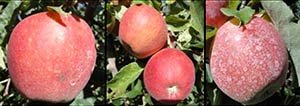
Visible residues of treated fruit showing control, left, Raynox, center, and Exlipse, right.
courtesy Washington Tree Fruit Research Commission
In response to industry concerns about complying with Maximum Residue Levels for pesticides in export markets, the Washington Tree Fruit Research Commission has been conducting residue studies to help apple and cherry growers make more informed choices about their spray programs.
The commission’s internal research program recently completed a 2013 study on Gala apples at Washington State University’s Sunrise Research Orchard near Wenatchee, using 14 insecticides or acaricides and eight fungicides commonly used in Washington orchards. They were applied with and without the sunburn controls Raynox (a waxy sunburn protectant) and Eclipse (a calcium carbonate and boron fertilizer that also protects fruit from sunburn). Fruit were analyzed for residues by a laboratory in Portland.
Results of the study, along with those from similar studies done on apple and cherry in 2011 and 2012, are available at the Research Commission’s Web site.

Leave A Comment